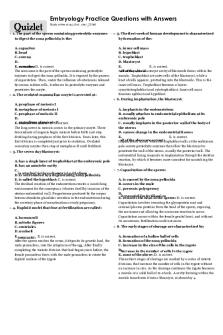Practice Questions PDF

| Title | Practice Questions |
|---|---|
| Course | Intro To Cell & Molecular Biol |
| Institution | Binghamton University |
| Pages | 2 |
| File Size | 64.2 KB |
| File Type | |
| Total Downloads | 37 |
| Total Views | 156 |
Summary
Practice Questions...
Description
PsbS gene is a gene in plants which codes for a protein called “pigment binding protein S” that is essential for proper photosystem II functioning. When PsbS is mutated, plants have a much slower rate of growth than is typical. They are “poor growing”. PSBS denotes the normal allele for this gene. psbs denotes the mutated, recessive allele for this gene. Pineapples have 25 chromosomes. PsbS is located on chromosome 22. 1. In a pineapple plant, ATP hydrolysis occurs regularly. Breaking the bond between the last two phosphates a) Requires more energy to be released than is absorbed when new bonds are formed with H2O. b) Requires less energy to be released than is absorbed when new bonds are formed with H2O. c) Requires more energy to be absorbed than is released when new bonds are formed with H2O. d) Requires less energy to be absorbed than is released when new bonds are formed with H2O. 2. Pineapples are CAM plants. What would be the result if pep carboxylase was inhibited such that it could not bind to CO2 when stomata were open? a) Calvin cycle would operate as normally. Photorespiration would not occur. b) Calvin cycle would operate as normally. Photorespiration would occur. c) Calvin cycle would slow down and eventually stop. Photorespiration would not occur. d) Calvin cycle would slow down and eventually stop. Photorespiration would occur. 3. Kiara’s genetic research reveals that the poor-growing pineapple plants are homozygous for the mutated form of PsbS. Meaning, they are psbs/psbs. As a result, photosystem II is not consistently donating electrons to NADP+ reductase. What is the immediate result when photosystem II fails to donate an electron to NADP+ reductase? a) Electrons move faster, photosystem II and I operate more quickly. b) Electrons back up, photosystem II stops working and photosystem I slows down. 4. The psbs/psbs genotype would ____ the Calvin cycle because the concentration of ATP and NAPHD would be ______. a) Speed up; reduced b) Speed up; increased c) Slow down; reduced d) Slow down, increased
5. Plants use the glucose created by photosynthesis in cellular respiration. How would the psbs/psbs genotype affect the rate of glycolysis? a) It would speed up b) It would slow down c) It would have no affect
6. If, in addition to the psbs/psbs genotype there was also a mutation in cyt a such that it’s oxidation potential was diminished, what would be the result? a) Electrons would accumulate upstream of cyt a, not including cyt a. b) Electrons would accumulate upstream of cyt a, including cyt a. c) Electrons would accumulate downstream of cyt a, not including cyt a. d) Electrons would accumulate downstream of cyt a, including cyt a. 7. Plants store any glucose not used in cellular respiration in the form of starch. Starch is composed of many individual glucose molecules bonded together. The chemical reaction that creates starch absorbs more energy in the breaking of the original glucose bonds, than is released when glucose molecules as bonded together. Therefore, a) It is an endergonic reaction. b) It is an exergonic reaction. DDBCBBA Calvin cycle not enough CO2 to keep it moving. Light dependent cycles are still happening and oxygen is still produced. Photorespiration would still occur. Photosystem II needs electrons to work. Photosystem I slows down because theres no electrons donated to NADP+ reductase. Electrons have no where to go....
Similar Free PDFs

Practice Questions
- 7 Pages

Practice+questions
- 1 Pages

Practice Questions
- 9 Pages

Practice Questions
- 14 Pages

Practice questions
- 235 Pages

Practice Questions
- 2 Pages

Practice questions
- 4 Pages

Practice Questions
- 2 Pages

practice questions
- 6 Pages

Wk 2 - Practice Questions
- 1 Pages

Embryology Practice Questions
- 16 Pages

Exam 2 practice questions
- 14 Pages

Ch5 - Practice Questions
- 8 Pages

Community Final Practice Questions
- 60 Pages
Popular Institutions
- Tinajero National High School - Annex
- Politeknik Caltex Riau
- Yokohama City University
- SGT University
- University of Al-Qadisiyah
- Divine Word College of Vigan
- Techniek College Rotterdam
- Universidade de Santiago
- Universiti Teknologi MARA Cawangan Johor Kampus Pasir Gudang
- Poltekkes Kemenkes Yogyakarta
- Baguio City National High School
- Colegio san marcos
- preparatoria uno
- Centro de Bachillerato Tecnológico Industrial y de Servicios No. 107
- Dalian Maritime University
- Quang Trung Secondary School
- Colegio Tecnológico en Informática
- Corporación Regional de Educación Superior
- Grupo CEDVA
- Dar Al Uloom University
- Centro de Estudios Preuniversitarios de la Universidad Nacional de Ingeniería
- 上智大学
- Aakash International School, Nuna Majara
- San Felipe Neri Catholic School
- Kang Chiao International School - New Taipei City
- Misamis Occidental National High School
- Institución Educativa Escuela Normal Juan Ladrilleros
- Kolehiyo ng Pantukan
- Batanes State College
- Instituto Continental
- Sekolah Menengah Kejuruan Kesehatan Kaltara (Tarakan)
- Colegio de La Inmaculada Concepcion - Cebu

